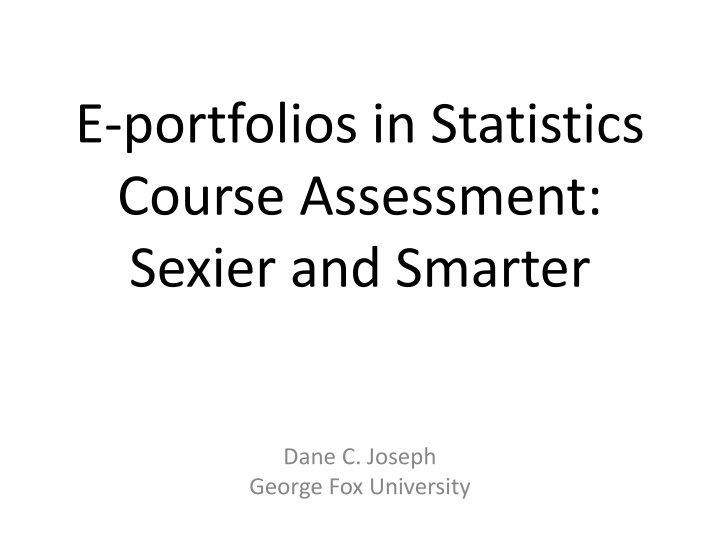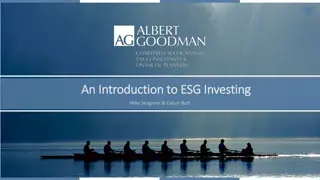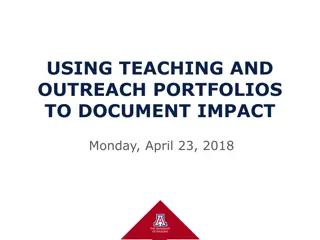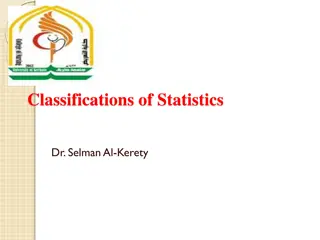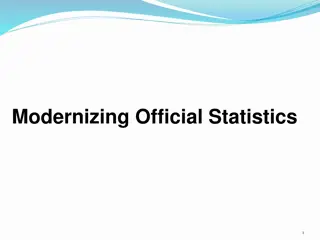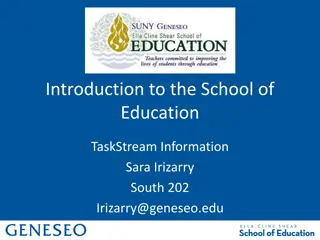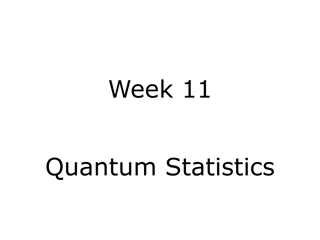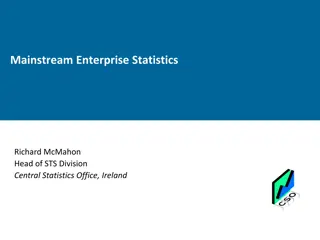E-portfolios in Statistics
This e-portfolio guide delves into the best practices for designing and utilizing e-portfolios in statistics courses. Explore concepts like validity, reliability, and fairness in assessment, with examples of e-portfolio applications in job and graduate program settings. Discover tips for both instructors and students on clear instructions, authenticity, and effective use of e-portfolios. Delve into the nuances of assessing, documenting, and applying e-portfolios, while considering factors like validity, fairness, and reliability.
Download Presentation

Please find below an Image/Link to download the presentation.
The content on the website is provided AS IS for your information and personal use only. It may not be sold, licensed, or shared on other websites without obtaining consent from the author.If you encounter any issues during the download, it is possible that the publisher has removed the file from their server.
You are allowed to download the files provided on this website for personal or commercial use, subject to the condition that they are used lawfully. All files are the property of their respective owners.
The content on the website is provided AS IS for your information and personal use only. It may not be sold, licensed, or shared on other websites without obtaining consent from the author.
E N D
Presentation Transcript
E-portfolios in Statistics Course Assessment: Sexier and Smarter Dane C. Joseph George Fox University
Purpose Best practices in the design and use of e-portfolios Examine the concepts of statistics course assessment validity, reliability, and fairness, and their application to e-portfolios Explore fictitious examples of utilizing academic statistics e-portfolios in job/graduate program applications
Audiences Rave About E-portfolios But why? Learning Artifact Professional Artifact Accountability Tool Bloom s Taxonomy Continuous Growth Performance Assessment Recall Pursuing statistical expertise is a process Responsibility distributed between instructor and student Understanding Applying Analyzing Evaluating Creating
E-portfolio Best Practices Instructors Students Design for clear instructions Design for authenticity & awareness --take nothing for granted --Present yourself --align to learning goals --Pack luggage wisely --show, don t tell --Remember: statistics is one major/course
E-portfolio Best Practices Instructors Use carefully when Students Use wisely when --advising --sharing --documenting --submitting --assessing --applying
Critics Say But wait, not so fast!!! Validity (Hit the Target) (Hit it Again) Fairness (By Groups) Reliability Content Inter-Observer Equality vs. Equity Construct Repeatability Legal Issues Criterion Alternate Forms Re-assess
Example: Deep-Sea Diving QUESTION/PROBLEM/HYPOTHESIS Ex: Examine the impact of an applet for teaching and learning the central limit theorem E- DESIGN SHARE Ex: Use literature from psychology and statistics courses Communicate results to various stakeholders Portfolio METHODS Ex: Experimental? Survey? Analytical procedures
Conclusion Sexy (def.): attractive, exciting, passionate Smart (def.): clever, quick-witted, shrewd Sexier and Smarter: adds quantity and/or quality Growth = good (caveat) when kept in check Assessment = defensible way to monitor growth
References Ambrose, A., Martin, H., & Page, H. (2014). Linking advising and e-portfolios for engagement: Design, evolution, assessment, and university-wide implementation. Peer Review, 16(1), 14. American Educational Research Association. (2014). Standards for educational and psychological testing. Washington, DC: American Educational Research Association. Anderson, L.W., & Krathwohl, D.R. (Eds.). (2000). A taxonomy for learning, teaching, and assessing: A revision of Bloom s taxonomy of educational objectives. New York, NY: Pearson Publications. Buzzetto-More, N. A., & Alade, A. J. (2006). Best practices in e-assessment. Journal of Information Technology Education, 5, 251. Carpenter, R., Apostel, S., & Hyndman, J.O. (2012). Developing a model for e-portfolio design: A studio approach. International Journal of e-Portfolio 2(2), 163-172. Ericsson, K.A., Prietula, M.J., & Cokely, E.T. (2007). The making of an expert. Harvard Business Review, July. Foshay, W.R., Villachica, S.W., & Stepich, D.A. (2013). Cousins but not twins: Instructional design and human performance technology in the workplace. In Spector, M.J., Merrill, M.D., & Elen, J., & Bishop, M.J. (Eds.), Handbook of Research on Educational Communications and Technology (4th ed.) (pps. 39-49). New York, NY: Springer. Garfield, J. (1994). Beyond Testing and Grading: Using Assessment To Improve Student Learning. Journal of Statistics Education, V2, 1. Gearhart, M., Herman, Joan L, & Educational Resources Information Center. (1995). Portfolio assessment whose work is it? Issues in the use of classroom assignments for accountability: [evaluation comment]. Washington, DC]: U.S. Dept. of Education, Office of Educational Research and Improvement, Educational Resources Information Center. Pitts, W., & Ruggirello, R. (2012). Using the e-portfolio to document and evaluate growth in reflective practice: The development and application of a conceptual framework. International Journal of e-Portfolio 2(1): 49-74. Shada, A., K. Kelly, R. Cox, and S. Malik. (2011). Growing a new culture of assessment: Planting e-portfolios in the Metro Academies Program. International Journal of e-Portfolio 1(1): 71-83. Silva, M.L., Delaney, S.A., Cochran, J., Jackson, R., & Olivares, C. (2015). Institutional assessment and the integrative core curriculum: Involving students in the development of an e-portfolio system. International Journal of e-Portfolio 5(2), 155-167.
Resources Five Texts & Journals to Continue your Journey 1. International Journal of e-Portfolio 1. Journal of Statistics Education 3. Journal of Research on Technology in Education 3. Light, T.P., Chen, H.L., Ittelson, J.C. (2011). Documenting learning with e-Portfolios: A guide for college instructors. Wiley: Jossey-Bass Publications. 3. Buzzetto-More, N. (2010). The e-Portfolio paradigm: Informing, educating, assessing, and managing with E- Portfolios. Informing Science Press.
Resources Five Websites to Continue Your Journey 1. The Association for Authentic, Experiential and Evidence-Based Learning (AAEEBL): http://www.aaeebl.org 2. The National Council of Teachers of English (NCTE) CCCC Resource Page on Principles and Practices in Electronic Portfolios: http://www.ncte.org/cccc/resources/positions/electronicportfolios 3. International Society for Technology in Education: http://www.iste.org/ 4. EDUCAUSE Library for e-portfolios: https://library.educause.edu/search#?q=eportfolios 5. University of Wisconsin Rubric for Evaluating E-Portfolios http://www2.uwstout.edu/content/profdev/rubrics/ePortfoliorubric.html
